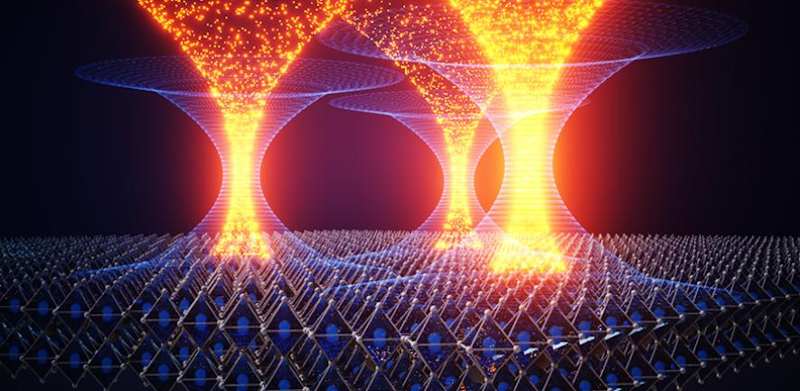The usual solar cell is made of silicon. The better cells use the crystalline form of the element, but there are other methods to obtain electric energy from the sun using silicon. Forming silicon crystals, though, can be expensive so there is always interest in different solar technologies. Perovskite is one of the leading candidates for supplanting silicon. Since they use lead salts, they are cheap and simple to construct. The efficiency is good, too, even when the material is not particularly well ordered. The problem is every model science has on what should make a good solar cell predicted that orderly compounds would perform better, even though this is not true for perovskite. Now scientists at Cambridge think they know why these cells perform even in the face of structural defects.
Perovskites take their name from a natural mineral that has the same atomic structure. In 2009, methylammonium lead halide perovskites were found to act as solar cells. Conversion rates can be as high as 25.5% according to sources and — apparently — the cells could be as much as 31% efficient, in theory. Solar cells top out — again, in theory — at 32.3% although in the real world you are lucky to get into the high twenties.
Using advanced microscopy, the team found that there were two different types of disorders occurring in the material. Electrical disorganization reduces the solar energy conversion performance. However, a corresponding chemical disorder is actually advantageous for efficiency and more than makes up for the electrical disadvantage.
The researchers hope this will offer new insights into how to create even better perovskite materials for use in the solar cells of the future. We’ve seen this material used for things other than solar cells. There is a lot of research activity centering on these cells, so we hope to see some practical applications, soon.
[Main image: Alex T. at Ella Maru Studios via University of Cambridge research announcement]
















Interesting!
I would like to see comparisons (when they become available) of the lifetime energy (cradle to grave) of perovskites v. silicon solar cells.
Didn’t we mostly stop using lead compounds in electronics products (ROHS)? Because you really don’t want these end up in your drinking water supplies.
Lead in most components and solder is difficult or not economical to recover for recycling, but a solar panel made mostly of a lead compound might be more amenable to recycling, much like lead acid batteries, which are already one of the most recycled items on the planet.
Strangely enough, molecular chemicals and ionic can behave extremely different. Like chlorine: in its molecular form it is a poisonous gas, but in its ionic form it is part of table salt!
True, but unfortunately the lead perovskite compounds are (or break down into) soluble, toxic compounds. The Wikipedia page on perovskite solar cells has a section on ongoing research on methods to mitigate this, including using compounds that don’t contain lead as well as improved packaging methods to ensure that lead doesn’t escape.
There is no way I’d put anything with lead or cadmium on my roof while also collecting rainwater given how brutal hailstorms are in my region, it is only a matter of time before they are destroyed with enough violence that the metal contaminates the entire system. At the moment we deal with the reality of storm damage via insurance but there is no cover that will compensate you for your property suffering heavy metal contamination of any type.
I think a microscopically thin film deposited inside a toughened glass panel with bonded backing is pretty unlikely to leach any quantity of lead into anything even if you smash it to pieces.
The quantites of lead (or anything else) inside these things per square metre is miniscule – especially compared to lead in solder (~40%+) or tetraethyl lead in petrol.
If its crystal structure uniformity doesn’t largely matter, then it should be fairly “simple” to deposit.
So no reason to make absurdly large layers above a few µm. Who knows, a few tens of nm might be sufficient.
Getting current to flow around would though require some more depositioning, but that is nothing special to be fair. It is just some base metal, followed by the thin PV crystal and then capping it off with a suitable transparent conductor with enough thickness to handle the current. One would still likely add some thicker non transparent conductors as a top mesh regardless as to greatly reduce resistive losses.
So the lead content might be a gram for every few square meters. And still likely be hard as hell to get out from the laminated stack.
I have worked with these hybrid organic-inorganic metal halide perovskite materials (not directly in solar cell applications, studying the material properties) and I am very very skeptical that they will ever be commercially useful for power generation.
They are chemically unstable, degrade rapidly when exposed to moisture or oxygen, a lot of them are suffer from photodegradation (so they decompose when exposed to light! Very useful property for a solar panel…) and above all else they degrade to various organometallic lead compounds most of which are water-soluble!
I don’t think the gains in quantum efficiency and carrier extraction efficiency will be sufficient to justify ignoring RoHS and deploying these on rooftops all over the world.
The big attraction of these materials is that you can deposit thin films via solution processes at close to ambient conditions, instead of having to do sputtering or epitaxial growth in a vacuum chamber. But it remains to be seen if this leads to a net reduction in manufactuiring cost/ lifetime cost of ownership compared to silicon solar cells considering that perovskite solar cells require very good (i.e. expensive) hermetic encapsulation to protect them from the air, and so far the chemical degradation severely limits lifetime anyway.